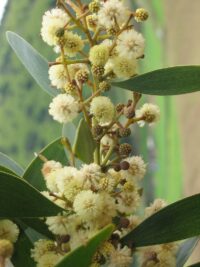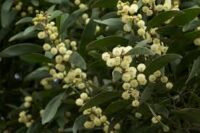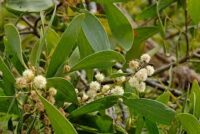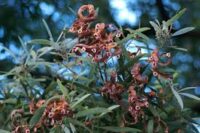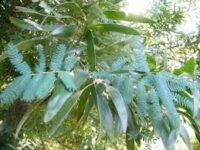Acacia melanoxylon, commonly known as the Australian blackwood, is a species of Acacia native to southeastern Australia.
Its resilience and adaptability make it a significant component of southeastern Australian ecosystems.
Taxonomy:
- Family: Fabaceae
- Genus: Acacia
Description:
- Growth: Medium-sized tree that typically grows up to 20-30 meters in height, though exceptional specimens can reach up to 45 meters. Trunk often straight and cylindrical, with a diameter of about 0.5 to 1 meter. Bark dark brown to blackish in color, deeply furrowed, and can have a rough texture.
- Leaves: Bipinnate, meaning they have paired leaflets arranged along the stem. Each leaf typically has 6-12 pairs of pinnae, each with 10-30 pairs of small leaflets.
- Flowers: Small, pale yellow, and arranged in globular clusters.
- Pod: Legume pod, usually around 5-10 cm long, containing several seeds.
Habitat and Distribution:
Acacia melanoxylon is indigenous to southeastern Australia, primarily found in the states of Victoria, New South Wales, Tasmania, and South Australia. It thrives in a variety of habitats, including wet forests, riverbanks, and mountain slopes. It prefers well-drained soils and can tolerate both acidic and alkaline conditions.
Hosts: (included but not limited to)
- Rainbow Lorikeet (Trichoglossus moluccanus): These colourful parrots feed on the tree’s nectar-rich flowers and may also consume small insects found in the foliage.
- Eastern spinebill (Acanthorhynchus tenuirostris): They play a crucial role in pollination as they feed on nectar and inadvertently transfer pollen between flowers.
- Common Ringtail Possum (Pseudocheirus peregrinus): This arboreal marsupial is known to feed on the leaves and fruits of Acacia melanoxylon. It uses the tree for shelter and as a source of food, contributing to its role in the tree’s dispersal of seeds.
- Koalas (Phascolarctos cinereus): While koalas primarily feed on eucalyptus leaves, they have been observed consuming Acacia melanoxylon leaves, especially in areas where their preferred eucalyptus species are scarce or absent.
Ecology and Uses:
- Biodiversity: Acacia melanoxylon provides habitat and food for various native fauna, including birds, insects, and mammals.
- Soil Stability: Its extensive root system helps prevent soil erosion, particularly in riparian areas.
- Nitrogen Fixation: Like other members of the Fabaceae family, Acacia melanoxylon has nodules on its roots that harbor nitrogen-fixing bacteria, enriching the soil with nitrogen.
- Timber: The wood is highly valued for its strength, durability, and attractive appearance. It is commonly used in furniture making, cabinetry, flooring, and musical instruments.
- Landscaping: Due to its ornamental value and fast growth rate, it is often planted in parks, gardens, and urban landscapes.
- Traditional Medicine: Various parts of the tree have been used in traditional Aboriginal medicine for treating ailments such as skin infections and coughs.
- Honey Production: The flowers of Acacia melanoxylon produce abundant nectar, making it a valuable resource for honey production
Links:
Acacia melanoxylon : Blackwood | Atlas of Living Australia (ala.org.au)

